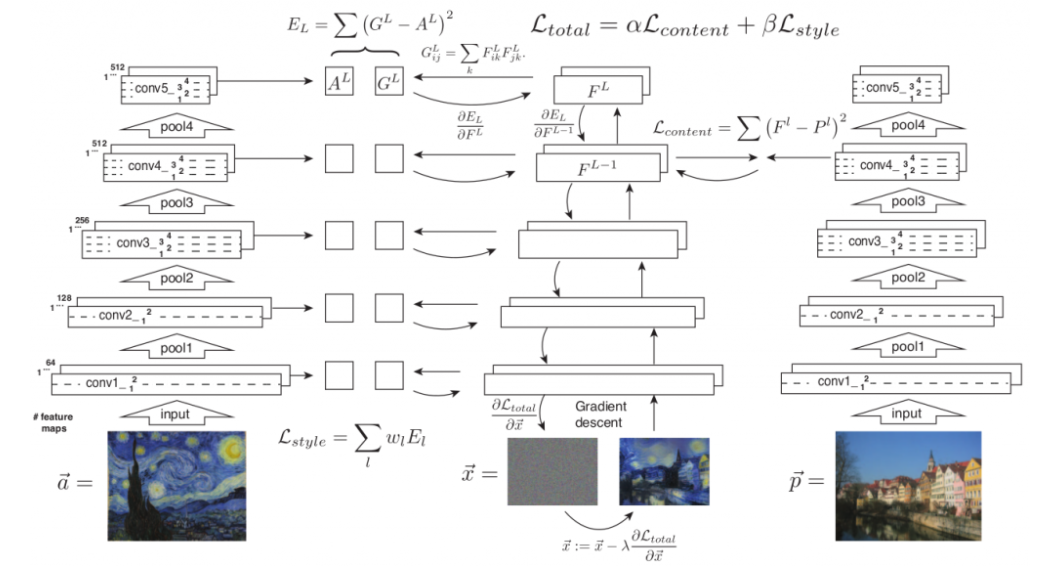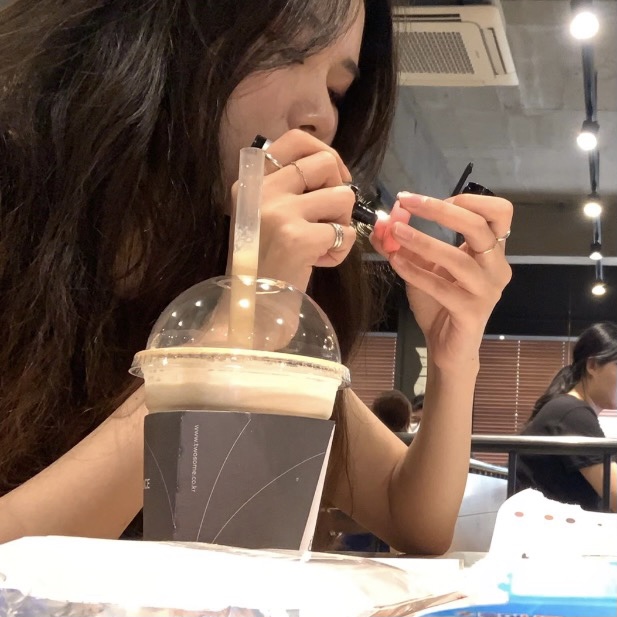전이 학습
- 특정 조건에서 얻어진 어떤 지식을 다른 상황에 맞게 '전이'하여 활용하는 학습방법
- 데이터 부족을 어느정도 해결할 수 있음
- 학습에 걸리는 시간이 줄어듬
- 시물레이션에서 학습된 모델을 현실에 적용할 수 있게 해줌
스타일 트랜스퍼
- 전이학습의 단적인 예로 범용이 가능하여 작업종류와 관계없이 물체를 인식하는 데 모두 적용될 수 있어 학습된 모델에서 얻은 지식을 다른 작업에 전이할 수 있음
스타일 트랜스퍼 모델 학습의 전체적 구조

L-BFGS 알고리즘
- 최적화 알고리즘으로 2차 미분값까지 이용
- 뉴턴 메서드 방법 : f(x)=0인 x에 수렴한다
- 값을 정확히 계산하는 대신 근사하는 방식으로 바꿔 연산 속도를 높임,O(n**2) 시간 소요
코드 구현
# https://discuss.pytorch.org/t/how-to-extract-features-of-an-image-from-a-trained-model/119/3
# https://github.com/leongatys/PytorchNeuralStyleTransfer
import torch
import torch.nn as nn
import torch.optim as optim
import torch.utils as utils
import torch.utils.data as data
import torchvision.models as models
import torchvision.utils as v_utils
import torchvision.transforms as transforms
from torch.autograd import Variable
import matplotlib.pyplot as plt
from PIL import Image
# hyperparameters
content_dir = "./image/content/Neckarfront_origin.jpg"
style_dir = "./image/style/monet.jpg"
content_layer_num = 4
image_size = 512
epoch = 10000
# import pretrained resnet50 model
# check what layers are in the model
resnet = models.resnet50(pretrained=True)
for name,module in resnet.named_children():
print(name)
# resnet without fully connected layers
# return activations in each layers
class Resnet(nn.Module):
def __init__(self):
super(Resnet,self).__init__()
self.layer0 = nn.Sequential(*list(resnet.children())[0:1])
self.layer1 = nn.Sequential(*list(resnet.children())[1:4])
self.layer2 = nn.Sequential(*list(resnet.children())[4:5])
self.layer3 = nn.Sequential(*list(resnet.children())[5:6])
self.layer4 = nn.Sequential(*list(resnet.children())[6:7])
self.layer5 = nn.Sequential(*list(resnet.children())[7:8])
def forward(self,x):
out_0 = self.layer0(x)
out_1 = self.layer1(out_0)
out_2 = self.layer2(out_1)
out_3 = self.layer3(out_2)
out_4 = self.layer4(out_3)
out_5 = self.layer5(out_4)
return out_0, out_1, out_2, out_3, out_4, out_5
# read & preprocess image
def image_preprocess(img_dir):
img = Image.open(img_dir)
transform = transforms.Compose([
transforms.Scale(image_size),
transforms.CenterCrop(image_size),
transforms.ToTensor(),
transforms.Normalize(mean=[0.40760392, 0.45795686, 0.48501961],
std=[1,1,1]),
])
img = transform(img).view((-1,3,image_size,image_size))
return img
# image post process
def image_postprocess(tensor):
transform = transforms.Normalize(mean=[-0.40760392, -0.45795686, -0.48501961],
std=[1,1,1])
img = transform(tensor.clone())
img[img>1] = 1
img[img<0] = 0
return 2*img-1
# show image given a tensor as input
def imshow(tensor):
image = tensor.clone().cpu()
image = image.view(3, image_size, image_size)
image = transforms.ToPILImage()(image)
plt.imshow(image)
plt.show()
# gram matrix
class GramMatrix(nn.Module):
def forward(self, input):
b,c,h,w = input.size()
F = input.view(b, c, h*w)
G = torch.bmm(F, F.transpose(1,2))
return G
# gram matrix mean squared error
class GramMSELoss(nn.Module):
def forward(self, input, target):
out = nn.MSELoss()(GramMatrix()(input), target)
return(out)
# initialize resnet and put on gpu
# model is not updated so .requires_grad = False
resnet = Resnet().cuda()
for param in resnet.parameters():
param.requires_grad = False
# get content and style image & image to be generated
content = Variable(image_preprocess(content_dir), requires_grad=False).cuda()
style = Variable(image_preprocess(style_dir), requires_grad=False).cuda()
generated = Variable(content.data.clone(),requires_grad=True)
v_utils.save_image(image_postprocess(image_preprocess(content_dir)),"./content.png")
v_utils.save_image(image_postprocess(image_preprocess(style_dir)),"./style.png")
# set targets and style weights
style_target = list(GramMatrix().cuda()(i) for i in resnet(style))
content_target = resnet(content)[content_layer_num]
style_weight = [1/n**2 for n in [64,64,256,512,1024,2048]]
# set LBFGS optimizer
# change the image through training
optimizer = optim.LBFGS([generated])
iteration = [0]
while iteration[0] < epoch:
def closure():
optimizer.zero_grad()
out = resnet(generated)
style_loss = [GramMSELoss().cuda()(out[i],style_target[i])*style_weight[i] for i in range(len(style_target))]
content_loss = nn.MSELoss().cuda()(out[content_layer_num],content_target)
total_loss = 1000 * sum(style_loss) + sum(content_loss)
total_loss.backward()
if iteration[0] % 100 == 0:
print(total_loss)
v_utils.save_image(image_postprocess(generated.data),"./gen_{}.png".format(iteration[0]))
iteration[0] += 1
return total_loss
optimizer.step(closure)***파이토치 첫걸음 (최건호 저) ch 8 요약
